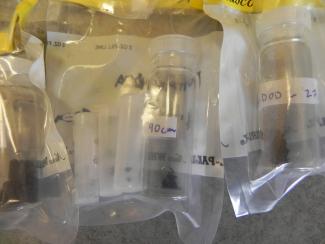
Making sure you’re submitting the right MATERIALS, in the right AMOUNTS, in the right WAY will make your radiocarbon experience fast and easy.
1) AVOID CONTAMINATION
- Before submitting samples, you must be sure that your lab is not contaminated with radiocarbon tracer. If your lab has never been tested for contamination, please discuss swiping for contamination with us.
- Please carefully consider where your samples have been stored and processed when thinking about possible sources of contamination. Common use areas (e.g. freezers, refrigerators, centrifuges, ovens) are usually the culprit .
2) ISOLATE YOUR SAMPLE
- Many samples are composites of different carbonaceous materials, so be sure to isolate the exact carbon that you want dated. For example, if you want to get a radiocarbon measurement on a soil, do you want to pick out the roots? Should you remove the particulate organic matter? What if there are carbonates in your soil? If you’re uncertain how or what part of your sample to isolate, please contact us.
- Be aware of (and beware of!) your sample handling procedures. Some methods can cause contamination of the sample with outside C sources, or cause isotopic fractionation of the sample. Lyophilization and photo oxidation procedures are many times likely to cause issues.
3) SEND THE RIGHT AMOUNT
- Each graphite sample contains only 1 mg of C, so large amounts of sample are generally not required. If you know the C content of your sample, calculate the mass of sample required to yield 1 mg of C and submit 2-3 times as much sample. This ensures that if the first attempt at graphitization is not successful, there is enough material on hand for subsequent tries.
- Some samples will require chemical pretreatment prior to graphitization. If you are not sure whether your sample should undergo pretreatment please contact us.
- If you do not know the %C value of your sample, but you anticipate a low C content, please send 1 g of material. If you anticipate a high C content, send 10 mg. If your samples are too small to send the above amounts, contact us to discuss your options.
4) PACKAGE YOUR SAMPLES CORRECTLY
- Do not send inappropriately large amounts of sample. Do not send unground bulk soil samples in plastic bags.
- Send the appropriate amount of sample, ground (unless advised otherwise), and either wrapped in foil and placed in a clean vial, or placed directly in a clean vial.
5) SEND THE RIGHT INFORMATION WITH YOUR SAMPLES
- In order to properly process you sample, we need to know the %C and the estimated age. If you require %C and δ13C analysis, and would like assistance finding a suitable stable isotope facility, please let us know. Estimated %C values are fine.
- Please do not use excessively long sample IDs.
